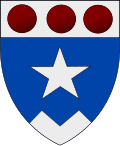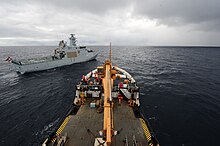Danish Armed Forces is the unified armed forces of the Kingdom of Denmark charged with the defence of Denmark and its self-governing territories Greenland and the Faroe Islands. The military also promote Denmark's wider interests, support international peacekeeping efforts and provide humanitarian aid.

The defence of Greenland is the responsibility of the Kingdom of Denmark; the government of Greenland does not have control of Greenland's military or foreign affairs. In the history of Greenland there have been many changes of presence regarding who is in charge of the security of Greenlandic people and its land.

The Royal Danish Navy is the sea-based branch of the Danish Armed Forces force. The RDN is mainly responsible for maritime defence and maintaining the sovereignty of Danish territorial waters. Other tasks include surveillance, search and rescue, icebreaking, oil spill recovery and prevention as well as contributions to international tasks and forces.
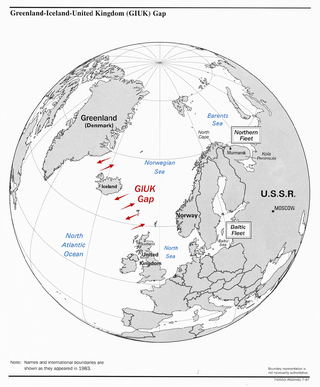
The GIUK gap is an area in the northern Atlantic Ocean that forms a naval choke point. Its name is an acronym for Greenland, Iceland, and the United Kingdom, the gap being the two stretches of open ocean among these three landmasses. It separates the Norwegian Sea and the North Sea from the open Atlantic Ocean. The term is typically used in relation to military topics. The area has for some nations been considered strategically important since the beginning of the 20th century.

The Inatsisartut, also known as the Parliament of Greenland in English, is the unicameral parliament of Greenland, an autonomous territory in the Danish Realm. Established in 1979, it meets in Inatsisartut, on the islet of Nuuk Center in central Nuuk.
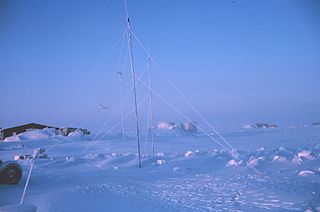
Station Nord is a military and scientific station in northeastern Greenland 1700 km north of the Arctic Circle.

The Greenland national football team represents Greenland in non-FIFA international tournaments. It is controlled by the Football Association of Greenland. Although it has the same status as the Faroe Islands within the Kingdom of Denmark, Greenland is not, unlike the Faroe Islands national football team, a member of FIFA nor of any continental confederation and therefore is not eligible to enter the World Cup or other sanctioned tournaments. Most of the matches they have played have been against the Faroe Islands and Iceland, but neither of the two consider those games full internationals. In May 2024, it was announced that Greenland had officially applied to become a member of CONCACAF.

Island Command Greenland, or simply "GLK", was a Level.II authority responsible directly to the Defence Command. It was, among other things, responsible for the military defense of Greenland, maritime and sovereignty maintenance and enforcement, as well as search and rescue. Personnel assigned to the Danish liaison office at Thule Air Base (FOTAB) as well as the Sirius Patrol were also a part of the Greenland Command. Island Command Greenland was amalgamated with Island Command Faroes to a Joint Arctic Command on 31 October 2012.

Kangilinnguit or Kangilínguit, formerly GrønnedalGreenlandic pronunciation:[kaŋiliŋːuit], is a settlement and location of a former naval base in Greenland's Sermersooq municipality, located at the mouth of Arsuk Fjord in southwestern Greenland. The settlement had 160 inhabitants in 2010, most of whom are Danish Navy personnel, attached to Island Command Greenland headquarters.
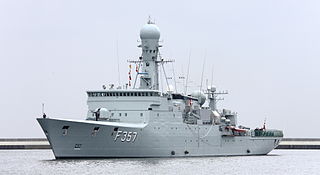
The Thetis-class ocean patrol vessels or ocean patrol frigates, also called Stanflex 3000, is a class of large patrol vessels built for the Royal Danish Navy. The class comprises four ships, all built and commissioned in the early 1990s. The ships' tasks are mainly maintenance of sovereignty, search and rescue, fishery inspection and support to local authorities. The operation areas are normally Greenland and the Faroe Islands, but the vessels also operate near Iceland on transit between Greenland and the Faroe Islands, and near Denmark.

The Danish Realm, officially the Kingdom of Denmark, or simply Denmark, is a sovereign state and refers to the area over which the monarch of Denmark is head of state. It consists of metropolitan Denmark—the kingdom's territory in continental Europe and sometimes called "Denmark proper" —and the realm's two autonomous regions: the Faroe Islands in the North Atlantic and Greenland in North America. The relationship between the three parts of the Kingdom is also known as The unity of the Realm.
Island Command Faroes was the military unit on the Faroe Islands. It was the military command of the Faroe Islands, the Faroe Islands airspace and the Faroe Islands territorial waters. It supported the local government with military advice as well as search and rescue capabilities. Island Command Faroes was amalgamated with Island Command Greenland to a Joint Arctic Command on 31 October 2012.

Eskadrille 721 of the Royal Danish Air Force is the sole squadron in 'Air Transport Wing Aalborg' of the Danish Defence. It provides tactical transport for all parts of the Danish state.
Maritime domain awareness (MDA) is defined by the International Maritime Organization as the effective understanding of anything associated with the maritime domain that could impact the security, safety, economy, or environment. MDA is said to work as a ‘key enabler’ for other maritime security issues, such as anti-piracy patrols, in the way that in order to do effective patrols you need to have the ability of conducting effective MDA. The maritime domain is defined as all areas and things of, on, under, relating to, adjacent to, or bordering on a sea, ocean, or other navigable waterway, including all maritime-related activities, infrastructure, people, cargo, and vessels and other conveyances.

The Arctic Policy of the Kingdom of Denmark defines the Kingdom's foreign relations and policies with other Arctic countries, and the Kingdom's strategy for the Arctic on issues occurring within the geographic boundaries of "the Arctic" or related to the Arctic or its peoples. In order to clearly understand the Danish geopolitical importance of the Arctic, it is necessary to mention Denmark's territorial claims in areas beyond its exclusive EEZ in areas around the Faroe Islands and north of Greenland covering parts of the North Pole, which is also claimed by Russia.
The Danish Defence Acquisition and Logistics Organization (DALO) is a joint service unit under the Ministry of Defence, tasked with purchase, service and support of equipment within the Danish Defence. It used to be known as the Danish Defence Material Service.
The Arctic Coast Guard Forum (ACGF) is an organisation which unites the coast guards of eight Arctic states: Canada, Denmark, Finland, Iceland, Norway, Russia, Sweden, and the United States. The ACGF's main task is "to foster safe, secure, and environmentally responsible maritime activity in the Arctic." Since its establishment in 2015, the ACGF has been enabling the coast guards from each member state to cooperate towards common objectives. The establishment of the ACGF is a response to the increasing levels of activities in the maritime domain in the Arctic, and with that associated need for coast guard services.
The Arctic policy of the Faroe Islands is a part of the Faroese government's policies and through the joint strategy of the Kingdom of Denmark, as well as within the Arctic Council.
Denmark participates in NATO as a maritime security ally. It has a maritime heritage and a position bridging Europe and the Arctic.
